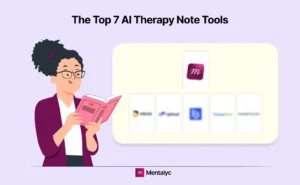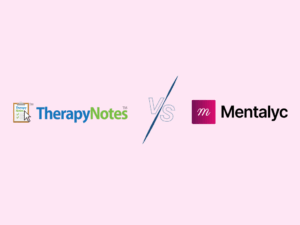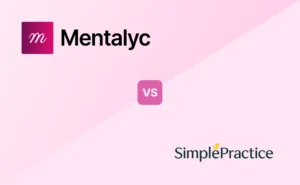BIRP notes are a type of note format used by many mental health professionals. BIRP notes have four distinct sections so you can follow along and ensure your documentation is professional and up to standard. If you’ve tried other progress note formats and can’t get on board, you may consider trying a BIRP note. BIRP notes focus on the therapist-client relationship and specifically address how the client responds to what the mental health professional is doing in the session.
What is a BIRP note?
A BIRP note is a type of clinical documentation used by mental health professionals and some healthcare providers to document the treatment plans and progression of their clients.
A BIRP note has four different sections:
- Behavior
- Intervention
- Response
- Plan
Each element of a BIRP note contains different information that’s necessary when documenting therapy sessions or other types of sessions with a client. For example, some Psychiatrists may use BIRP notes with their clients to record what they discussed.

New! Transfer your notes to EHR with a single click. No more copy-pasting.
How to write a BIRP note
BIRP notes follow each section of the acronym. Therefore, when you write BIRP notes, consider following this format.
Behavior
The “B” in BIRP note stands for behavior. The behavior section includes information about your client’s behavior, such as their appearance in session and what they’re reporting is occurring outside of the session. This section consists of both subjective and objective information.
In the behavior section, you may include information such as:
- Emotional state
- Appearance
- Feelings about therapy
- Client’s report of their symptoms
- Client homework from the previous session
You would document anything you notice that is an observable trait of the client under this section.
Intervention
The “I” in BIRP note stands for intervention. This section of birp notes includes what the mental health professional does in response to the client’s behavior and any interventions you use.
The intervention section may include information such as:
- Specific tasks you give the client
- Coping skills
- Any interventions you provide
In the intervention, it should be clear what theoretical approach you use with clients in therapy sessions.
Response
The “R” in BIRP note stands for the response. The response section includes how the client responded to the therapist’s interventions.
The response section may include information such as:
- How a client used or didn’t use a particular intervention
- Barriers to implementing interventions
- Helpful skills
- Unhelpful skills
The response section gives clinicians clues about what the client feels is helpful and unhelpful so you can redirect treatment if necessary or keep the same focus in their sessions.
Plan
The “P” in BIRP note stands for the plan. The plan section includes what happens next after the client’s session.
The plan section may include information such as:
- The date and time of the next session
- Client homework assigned
- Any outside referrals
- The focus of the next session
The plan section should be based on the client’s behavior during the session, what they are reporting, and your clinical judgment about what may be next for them.
BIRP note Example for depression
If you’re wondering how your BIRP notes should look, here’s an example of a good BIRP note for depression:
Behavior in BIRP
The client presents for a virtual teletherapy appointment today. The client’s presenting problem is a depressed mood. The client appears lethargic and is well-dressed with appropriate hygiene. The client presents with a flat affect. The client reports that they have been sleeping during most of their downtime when they aren’t at work.
The client states, “I feel like I have no energy, and motivating myself to do the things I enjoy in my downtime is difficult.” Client reports occasional suicidal ideation on and off but denies a plan or intent to act on those thoughts. Client also states they have been experiencing increased stress at work and are finding it difficult to concentrate.
Intervention in BIRP
The therapist educated the client on behavioral activation techniques, and the client was receptive to this. They aim to read for ten minutes before the next session as a behavioral activation exercise. The therapist addressed the client’s suicidal ideation, and the therapist and client developed a safety plan and scheduled a check-in before the next session.
The therapist modeled stress management techniques for the client during the session, such as tapping and meditation. The therapist also helped the client identify obstacles to lowered concentration at work and will take time in the next session to help with interventions for concentration.
Response in BIRP
The client reported feeling better after identifying positive supports and coping skills in their safety plan. They were also receptive to behavioral activation exercises.
Plan in BIRP
The therapist and client will meet again next Tuesday at 3 p.m. The therapist and client scheduled a phone check-in for three days from now to check on the suicidal ideation they’re experiencing. Client was also referred to their primary care physician to discuss obtaining medication for depression. In addition, the client will work on behavioral activation exercises before the next session.
BIRP notes interventions
In the intervention section, knowing which words to use may be challenging. For BIRP notes in counseling, here are some common intervention words that you may use:
- Assisted
- Reinforced
- Developed
- Identified
- Discussed
- Explored
- Challenged
- Clarified
- Prompted
- Educated
- Supported
- Reframed
- Redirected
- Guided
- Affirmed
- Modeled
While this isn’t an all-encompassing list, these actionable words may help you improve your intervention section.
How to write BIRP notes faster
BIRP notes don’t take long to write; the BIRP format is a rapid note format for your documentation. If you want to write BIRP notes faster, here are some ideas for speeding up the process:
- Follow a BIRP notes template
- Build off your existing BIRP notes with long-term clients
- Use client quotes in the behavior section
- Keep an intervention list for words to use in your intervention part
- Document only the necessary information—don’t make your notes overly lengthy
These tips may help you become more effective at writing BIRP notes.
Well, here I will add one thing, using the Mentalyc AI note-taking app for therapists is a much better and faster option than writing progress notes in BIRP format. This app uses audio recordings of therapy sessions and converts them into progress notes, written in a standardized format that is easier to read and understand. Furthermore, this app eliminates the tedious task of manually transcribing each session into notes, thereby saving time and increasing accuracy. Additionally, the AI-generated notes can be edited according to the therapist’s preferences, making them more personalized and comprehensive. With Mentalyc mental health professionals can quickly generate accurate and up-to-date progress reports with minimal effort.
BIRP notes vs. SOAP notes
If you’re wondering how BIRP notes compare to SOAP (subjective, objective, assessment and plan) notes, there are various similarities and differences. Both note formats have an easy template to follow and include four different sections. They are meant to make documenting your sessions easier and take a short time to complete.
The differences lie in what each section consists of. For example, in the behavior section of a BIRP note, you’re reporting the client’s affect, behavior, and their report of their symptoms. However, when comparing the behavior section to a SOAP note, the SOAP note documents client behavior in the subjective and objective areas.
In a BIRP note, the therapist also documents specific interventions they use and how the client responds to them. The SOAP note does not include an intervention section but rather an assessment section that discusses a diagnosis and how the client is responding to goals in counseling.
The BIRP and SOAP notes contain a plan section that discusses the next steps in a client’s treatment. This section is essential as you include any homework, outside referrals, and the time and date of the next session.
BIRP notes vs. DAP notes
If you’re wondering how BIRP notes compare to DAP (Data, Assessment, and Plan) notes, there are more differences than similarities. In BIRP documentation, you focus on the client’s behavior in the first section. The DAP note also includes client behavior in the first section, the “data” section. All data obtained from your client in a BIRP note is included in the behavior section.
BIRP notes do not include an assessment section as DAP notes do. BIRP notes focus on the interventions and responses, while DAP notes focus on clinical observations and judgments.
Similarly, both note formats include a plan section addressing the client’s next treatment steps.
Benefits of BIRP notes
BIRP notes have several benefits. BIRP notes include necessary information for billing purposes but are also an easy read for those who can access your notes. Once you learn the format, they won’t take up a lot of time. Because of their simplified template, tracking your client’s progress from session to session is simple.
This note format also focuses heavily on the relationship between the client and the therapist. BIRP documentation focuses a lot on how the client responds to the specific interventions the therapist uses, which differs from some of the other note formats you may consider.
This note format can also be used in various mental health and healthcare settings. It can be used for counselors, psychologists, nurses, and even doctors can use this note format for documenting their time with a client. Many counselors like the BIRP documentation because of its ease.
BIRP notes cheat sheet
Here is a quick guide to help you remember the BIRP notes format and make writing each section of your session easier:
Behavior
In this section document:
- Affect
- Appearance
- Client reports of their symptoms
- Client emotion
Intervention
In this section document:
- What the therapist did
- What interventions you used
Response
In this section document:
- How the client responded to interventions
- Client’s report of what is and isn’t working for them
Plan
In this section document:
- Date and time of next session
- Outside referrals
- Homework
When you use this guide to write BIRP notes, you may learn the format quickly, and BIRP notes will be a breeze.
Disclaimer
All examples of mental health documentation are fictional and for informational purposes only.
Why other mental health professionals love Mentalyc

“A lot of my clients love the functionality where I can send them a summary of what we addressed during the session, and they find it very helpful and enlightening.”
Therapist

“Having Mentalyc take away some of the work from me has allowed me to be more present when I’m in session with clients … it took a lot of pressure off.”
LPC

“By the end of the day, usually by the end of the session, I have my documentation done. I have a thorough, comprehensive note … It’s just saving me hours every week.”
CDCII

“It’s so quick and easy to do notes now … I used to stay late two hours to finish my notes. Now it’s a breeze.”
Licensed Professional Counselor






